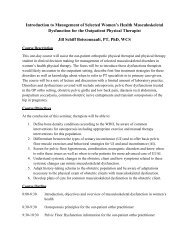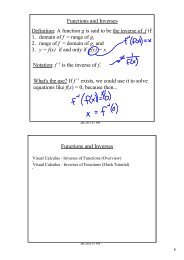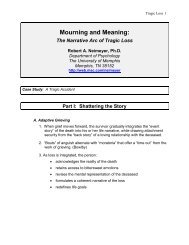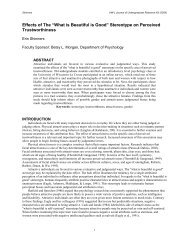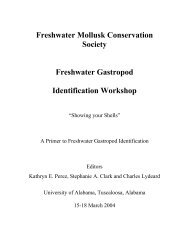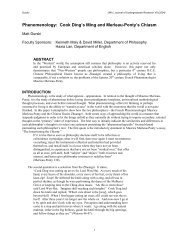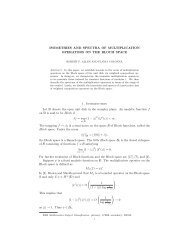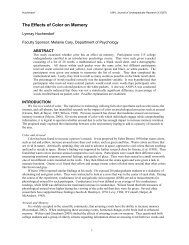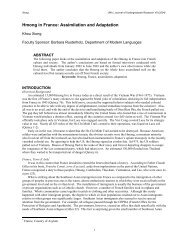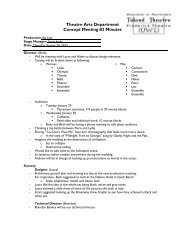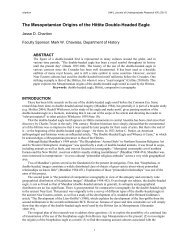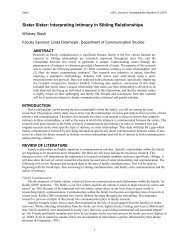A Good Study Break: Effects of Nature versus TV on Attention
A Good Study Break: Effects of Nature versus TV on Attention
A Good Study Break: Effects of Nature versus TV on Attention
Create successful ePaper yourself
Turn your PDF publications into a flip-book with our unique Google optimized e-Paper software.
Berigan and Pielage UW-L Journal <str<strong>on</strong>g>of</str<strong>on</strong>g> Undergraduate Research XVI (2013)<br />
A <str<strong>on</strong>g>Good</str<strong>on</strong>g> <str<strong>on</strong>g>Study</str<strong>on</strong>g> <str<strong>on</strong>g>Break</str<strong>on</strong>g>: <str<strong>on</strong>g>Effects</str<strong>on</strong>g> <str<strong>on</strong>g>of</str<strong>on</strong>g> <str<strong>on</strong>g>Nature</str<strong>on</strong>g> <str<strong>on</strong>g>versus</str<strong>on</strong>g> <str<strong>on</strong>g>TV</str<strong>on</strong>g> <strong>on</strong> Attenti<strong>on</strong><br />
Hilary Berigan, Nicole Pielage<br />
Faculty Sp<strong>on</strong>sor: Dr. Katherine Kortenkamp, Department <str<strong>on</strong>g>of</str<strong>on</strong>g> Psychology<br />
ABSTRACT<br />
Recent research has found fascinating c<strong>on</strong>necti<strong>on</strong>s between nature exposure and human well-being. In<br />
particular, previous research suggests that nature is a restorative envir<strong>on</strong>ment for attenti<strong>on</strong> <strong>on</strong>ce an<br />
individual experiences mental fatigue. This study investigates whether the viewing <str<strong>on</strong>g>of</str<strong>on</strong>g> natural envir<strong>on</strong>ments<br />
<strong>on</strong> televisi<strong>on</strong> allows for regenerati<strong>on</strong> <str<strong>on</strong>g>of</str<strong>on</strong>g> attenti<strong>on</strong> as well. Participants were assigned to <strong>on</strong>e <str<strong>on</strong>g>of</str<strong>on</strong>g> four 20<br />
minute study breaks: viewing either a completely natural setting in a park near campus, a semi-built<br />
envir<strong>on</strong>ment <strong>on</strong> campus, nature <str<strong>on</strong>g>TV</str<strong>on</strong>g>, or a popular sitcom. There attenti<strong>on</strong> was tested before and after the<br />
treatments using a backwards digit-span test. While no significant results were found, a trend suggested that<br />
nature was the most restorative <str<strong>on</strong>g>of</str<strong>on</strong>g> the four treatments. This tells us that nature <strong>on</strong> <str<strong>on</strong>g>TV</str<strong>on</strong>g> cannot replace the<br />
real experience.<br />
INTRODUCTION<br />
The w<strong>on</strong>ders <str<strong>on</strong>g>of</str<strong>on</strong>g> nature never cease to amaze us. Everyday it seems we are finding more aspects <str<strong>on</strong>g>of</str<strong>on</strong>g> nature that<br />
are truly incredible. Recent research has found fascinating c<strong>on</strong>necti<strong>on</strong>s between nature and human well-being (e.g.,<br />
Kaplan, 1995; Kaplan & Berman, 2010; Tennessen, 1995; Hartig, 2003). Because <str<strong>on</strong>g>of</str<strong>on</strong>g> this research, we turned to<br />
nature to find a soluti<strong>on</strong> to a comm<strong>on</strong> problem faced by college students: How to restore attenti<strong>on</strong> after experiencing<br />
mental fatigue. After hours <str<strong>on</strong>g>of</str<strong>on</strong>g> studying, many cope with this feeling in a variety <str<strong>on</strong>g>of</str<strong>on</strong>g> ways such as watching<br />
televisi<strong>on</strong>, going for a walk, or listening to music. The questi<strong>on</strong> is, which activity best helps students restore their<br />
attenti<strong>on</strong> following mental fatigue?<br />
To begin to solve the problem <str<strong>on</strong>g>of</str<strong>on</strong>g> maintaining attenti<strong>on</strong>, it is necessary to understand the best way to restore it<br />
when it is fatigued. Extensive research <strong>on</strong> mental fatigue led to Kaplan’s (1995) theory known as attenti<strong>on</strong><br />
restorati<strong>on</strong> theory (ART). ART explains mental fatigue as a result <str<strong>on</strong>g>of</str<strong>on</strong>g> the depleti<strong>on</strong> <str<strong>on</strong>g>of</str<strong>on</strong>g> voluntary, direct attenti<strong>on</strong>, or<br />
in other words, the attenti<strong>on</strong> we actively and effortfully use while focusing <strong>on</strong> a specific task. Although this type <str<strong>on</strong>g>of</str<strong>on</strong>g><br />
attenti<strong>on</strong> is voluntary, it is still susceptible to fatigue and must be restored through the use <str<strong>on</strong>g>of</str<strong>on</strong>g> involuntary attenti<strong>on</strong>.<br />
When involuntary attenti<strong>on</strong> is engaged, voluntary attenti<strong>on</strong> is at rest. Restorative envir<strong>on</strong>ments evoke involuntary<br />
attenti<strong>on</strong>. According to ART, for an envir<strong>on</strong>ment to be c<strong>on</strong>sidered restorative, it must have four comp<strong>on</strong>ents: (1)<br />
ability to provide feelings <str<strong>on</strong>g>of</str<strong>on</strong>g> being away (from the fatiguing envir<strong>on</strong>ment), (2) extent (a rich envir<strong>on</strong>ment), (3)<br />
compatibility (feeling that it is easy and enjoyable), and (4) fascinati<strong>on</strong> (naturally holding your interest). Kaplan<br />
identified two different forms <str<strong>on</strong>g>of</str<strong>on</strong>g> fascinati<strong>on</strong>--hard and s<str<strong>on</strong>g>of</str<strong>on</strong>g>t. Hard fascinati<strong>on</strong> involves stimuli that capture all <str<strong>on</strong>g>of</str<strong>on</strong>g> your<br />
attenti<strong>on</strong> with no room for mental reflecti<strong>on</strong> (e.g., bright lights, loud noises). While s<str<strong>on</strong>g>of</str<strong>on</strong>g>t fascinati<strong>on</strong> captures your<br />
attenti<strong>on</strong> but allows for mental reflecti<strong>on</strong> (e.g., quiet music).<br />
Natural settings can act as restorative envir<strong>on</strong>ments (Kaplan & Berman, 2010; Tennessen, 1995). A natural<br />
envir<strong>on</strong>ment interventi<strong>on</strong> has shown to have psychological benefits not <strong>on</strong>ly in terms <str<strong>on</strong>g>of</str<strong>on</strong>g> attenti<strong>on</strong> restorati<strong>on</strong> but also<br />
in decreasing blood pressure, increasing positive emoti<strong>on</strong>s, and decreasing anger and aggressi<strong>on</strong> (Hartig, 2003).<br />
Furthermore, studies have found this type <str<strong>on</strong>g>of</str<strong>on</strong>g> natural envir<strong>on</strong>ment treatment to help with informati<strong>on</strong> processing<br />
limitati<strong>on</strong>s and the cognitive side effects <str<strong>on</strong>g>of</str<strong>on</strong>g> living with cancer (Kaplan & Berman, 2010). This may be because<br />
natural envir<strong>on</strong>ments possess all four comp<strong>on</strong>ents <str<strong>on</strong>g>of</str<strong>on</strong>g> restorative envir<strong>on</strong>ments. Berman, J<strong>on</strong>ides, and Kaplan (2008)<br />
looked at the cognitive attenti<strong>on</strong>al benefits gained from being in a natural envir<strong>on</strong>ment. They found that those who<br />
walked in a park did significantly better <strong>on</strong> an attenti<strong>on</strong> test than participants who walked downtown. The<br />
implicati<strong>on</strong>s <str<strong>on</strong>g>of</str<strong>on</strong>g> this study are important in terms <str<strong>on</strong>g>of</str<strong>on</strong>g> showing nature’s restorative effects <strong>on</strong> attenti<strong>on</strong>; however, it<br />
does not address the effects in terms <str<strong>on</strong>g>of</str<strong>on</strong>g> different intensities <str<strong>on</strong>g>of</str<strong>on</strong>g> nature exposure.<br />
Berto (2005) examined a lower level <str<strong>on</strong>g>of</str<strong>on</strong>g> intensity <str<strong>on</strong>g>of</str<strong>on</strong>g> nature exposure that involved viewing pictures <str<strong>on</strong>g>of</str<strong>on</strong>g> nature<br />
instead <str<strong>on</strong>g>of</str<strong>on</strong>g> experiencing it directly by going <strong>on</strong> a walk. Participants who viewed pictures <str<strong>on</strong>g>of</str<strong>on</strong>g> nature scenes did better<br />
<strong>on</strong> the attenti<strong>on</strong> test than those who viewed pictures <str<strong>on</strong>g>of</str<strong>on</strong>g> urban scenes. Thus previous research shows that both<br />
spending time in nature and viewing nature photographs are restorative activities that improve directed, focused<br />
attenti<strong>on</strong>. Felsten (2009) also looked into different intensities <str<strong>on</strong>g>of</str<strong>on</strong>g> nature exposure. College students’ preferences for<br />
places to take study breaks <strong>on</strong> campus were examined. Results showed that students preferred murals <str<strong>on</strong>g>of</str<strong>on</strong>g> beautiful<br />
nature as more restorative than actual views <str<strong>on</strong>g>of</str<strong>on</strong>g> mundane nature and views without nature. So we know that murals<br />
1
Berigan and Pielage UW-L Journal <str<strong>on</strong>g>of</str<strong>on</strong>g> Undergraduate Research XVI (2013)<br />
<str<strong>on</strong>g>of</str<strong>on</strong>g> nature are perceived as beneficial for study breaks, but how does this compare to other ways that students relax<br />
when they are fatigued?<br />
Many college students in fact do not spend their study breaks looking at natural pictures or taking a nature walk.<br />
Instead, many choose to watch <str<strong>on</strong>g>TV</str<strong>on</strong>g>, YouTube videos, or movies. However, recent research has challenged the idea<br />
that these activities have restorative effects. Swing (2010) studied the effects <str<strong>on</strong>g>of</str<strong>on</strong>g> televisi<strong>on</strong> <strong>on</strong> attenti<strong>on</strong>. This study<br />
found time spent watching televisi<strong>on</strong> negatively affected performance <strong>on</strong> attenti<strong>on</strong> tests.<br />
The current study hopes to fill a gap in the existing literature by further investigating the c<strong>on</strong>necti<strong>on</strong> between<br />
<str<strong>on</strong>g>TV</str<strong>on</strong>g> viewing and attenti<strong>on</strong>, including the potential effects <str<strong>on</strong>g>of</str<strong>on</strong>g> nature <str<strong>on</strong>g>TV</str<strong>on</strong>g> (e.g., the film series Planet Earth) <strong>on</strong> attenti<strong>on</strong><br />
restorati<strong>on</strong>. Although there are several studies that support the use <str<strong>on</strong>g>of</str<strong>on</strong>g> nature in attenti<strong>on</strong> restorati<strong>on</strong>, n<strong>on</strong>e have<br />
looked into the use <str<strong>on</strong>g>of</str<strong>on</strong>g> nature videos. Research has also not compared the effects <str<strong>on</strong>g>of</str<strong>on</strong>g> nature exposure to <str<strong>on</strong>g>TV</str<strong>on</strong>g> exposure.<br />
Additi<strong>on</strong>ally, no studies look at the questi<strong>on</strong> <str<strong>on</strong>g>of</str<strong>on</strong>g> how l<strong>on</strong>g these attenti<strong>on</strong>al benefits can last, which is an important<br />
aspect to c<strong>on</strong>sider when applying these practices to real life situati<strong>on</strong>s. If the restorative effects <str<strong>on</strong>g>of</str<strong>on</strong>g> viewing nature<br />
<strong>on</strong>ly last for a few minutes, students will lose focus quickly and researchers may want to begin looking into different<br />
ways to restore attenti<strong>on</strong>.<br />
Based <strong>on</strong> previous research we hypothesize that experiencing actual nature will result in significantly better<br />
attenti<strong>on</strong> scores than watching nature shows, watching popular programs <strong>on</strong> televisi<strong>on</strong>, and experiencing semi-built<br />
envir<strong>on</strong>ments that include green space as well as buildings (e.g., a college campus). In additi<strong>on</strong>, we hypothesize that<br />
watching nature <str<strong>on</strong>g>TV</str<strong>on</strong>g> and experiencing a semi-built envir<strong>on</strong>ment will result in a significantly better performance <strong>on</strong><br />
the attenti<strong>on</strong> test than watching popular <str<strong>on</strong>g>TV</str<strong>on</strong>g>. Because there is no previous research <strong>on</strong> the durati<strong>on</strong> <str<strong>on</strong>g>of</str<strong>on</strong>g> restorative<br />
benefits, the current study will also explore how l<strong>on</strong>g these attenti<strong>on</strong>al benefits last.<br />
Method<br />
Participants<br />
In this study there were 70 participants recruited from the University <str<strong>on</strong>g>of</str<strong>on</strong>g> Wisc<strong>on</strong>sin-La Crosse through a website<br />
that enables them to sign up <strong>on</strong>line. Participants c<strong>on</strong>sisted <str<strong>on</strong>g>of</str<strong>on</strong>g> students from a variety <str<strong>on</strong>g>of</str<strong>on</strong>g> majors who signed up for the<br />
study with a mean age <str<strong>on</strong>g>of</str<strong>on</strong>g> 19.37 years (SD =1.55). However 7 participants had to be removed from the study due to<br />
cheating <strong>on</strong> the attenti<strong>on</strong> test so <strong>on</strong>ly 63 participants were used to c<strong>on</strong>duct the results <str<strong>on</strong>g>of</str<strong>on</strong>g> this study. Participants were<br />
compensated by having their name entered into a drawing to win <strong>on</strong>e <str<strong>on</strong>g>of</str<strong>on</strong>g> four $25 gift cards to the Three River<br />
Outdoors sporting shop.<br />
Materials and Procedure<br />
The design for this study was a single factor between-subjects design. The experimental variable was<br />
participants’ restorative activity (viewing actual nature, viewing a semi-built envir<strong>on</strong>ment, viewing nature <str<strong>on</strong>g>TV</str<strong>on</strong>g>, and<br />
viewing popular <str<strong>on</strong>g>TV</str<strong>on</strong>g>). The dependent variables included initial attenti<strong>on</strong> and l<strong>on</strong>ger term attenti<strong>on</strong>. Attenti<strong>on</strong> was<br />
measured using an assessment known as the Backwards Digit Span Test (Wechsler, 1955) taken before and after<br />
each restorative activity and repeated 10 minutes after the activity ended. This test has been successfully used in<br />
many attenti<strong>on</strong> restorati<strong>on</strong> studies (e.g., Berman et al., 2008; Taylor & Kuo, 2009). We used an oral versi<strong>on</strong> <str<strong>on</strong>g>of</str<strong>on</strong>g> this<br />
test that involved reading <str<strong>on</strong>g>of</str<strong>on</strong>g>f digit sequences (e.g., 7-3-5) and having participants write down the numbers<br />
backwards. The participants heard previously recorded sequences <str<strong>on</strong>g>of</str<strong>on</strong>g> numbers that increased by number <str<strong>on</strong>g>of</str<strong>on</strong>g> digits<br />
every two sequences. To further explain, the first two sequences <strong>on</strong>ly had two digits (7-5, 6-4) while the third and<br />
fourth had three (8-4-5; 7-9-1). Every two sequences served as <strong>on</strong>e level. Therefore, every participant heard fourteen<br />
sequences that equaled seven levels. If the participant got the first sequence <str<strong>on</strong>g>of</str<strong>on</strong>g> the level right, then they passed that<br />
level. If they got the first sequence wr<strong>on</strong>g, but the sec<strong>on</strong>d sequence right, then they passed that level as well. If both<br />
sequences were wr<strong>on</strong>g then they did not pass, the scorer looked at no more sequences, and the score (1-7) reflected<br />
the furthest level the participant successfully passed. (Berman et al., 2008).<br />
Before the study, all participants signed the informed c<strong>on</strong>sent waiver, filled out a demographic survey and<br />
listened to an introducti<strong>on</strong> to the study in a classroom close to where their treatment took place. After this, every<br />
participant performed an attenti<strong>on</strong>-fatiguing task for 10 minutes. The task was a syllogisms test that was designed to<br />
force participants to use logical deductive reas<strong>on</strong>ing to answer questi<strong>on</strong>s (Holmquist, 1974). We chose to use this<br />
task since it was successfully used in another study that looked at the restorative effects <str<strong>on</strong>g>of</str<strong>on</strong>g> nature (Kjellgren, 2010).<br />
There were 15 multiple-choice questi<strong>on</strong>s that participants had to answer <strong>on</strong> a sheet <str<strong>on</strong>g>of</str<strong>on</strong>g> paper in order to fatigue their<br />
directed attenti<strong>on</strong>. Next, participants took the first digit span test (pretest).<br />
Following this, each participant was randomly assigned into <strong>on</strong>e <str<strong>on</strong>g>of</str<strong>on</strong>g> the three restorative c<strong>on</strong>diti<strong>on</strong>s (semi-built,<br />
popular <str<strong>on</strong>g>TV</str<strong>on</strong>g>, nature <str<strong>on</strong>g>TV</str<strong>on</strong>g>) or they were assigned to the nature c<strong>on</strong>diti<strong>on</strong> based <strong>on</strong> the sessi<strong>on</strong> they signed up for. This<br />
modificati<strong>on</strong> was made because the first three c<strong>on</strong>diti<strong>on</strong>s could be experienced <strong>on</strong> campus while the fourth needed to<br />
2
Berigan and Pielage UW-L Journal <str<strong>on</strong>g>of</str<strong>on</strong>g> Undergraduate Research XVI (2013)<br />
be c<strong>on</strong>ducted <str<strong>on</strong>g>of</str<strong>on</strong>g>f campus. This made it impossible for all four c<strong>on</strong>diti<strong>on</strong>s to be c<strong>on</strong>ducted <strong>on</strong> the same day and<br />
completely random assignment could not take place.<br />
For the c<strong>on</strong>diti<strong>on</strong> <str<strong>on</strong>g>of</str<strong>on</strong>g> viewing nature, participants sat outside in a park with views <str<strong>on</strong>g>of</str<strong>on</strong>g> <strong>on</strong>ly natural settings. In this<br />
case they could see trees, a marsh, grass and some wildlife. To view a semi-built envir<strong>on</strong>ment, participants were<br />
asked to sit <strong>on</strong> the grass <strong>on</strong> the university’s campus, which has both natural structures (trees and grass) and built<br />
structures (buildings, sidewalks) in view. Both televisi<strong>on</strong> c<strong>on</strong>diti<strong>on</strong>s took place inside in separate rooms using<br />
computers to deliver the stimuli. The nature <str<strong>on</strong>g>TV</str<strong>on</strong>g> c<strong>on</strong>diti<strong>on</strong> involved viewing a segment <str<strong>on</strong>g>of</str<strong>on</strong>g> Planet Earth with<br />
envir<strong>on</strong>mental settings similar to Midwest envir<strong>on</strong>ments (forests, lakes, rivers, etc.). The popular <str<strong>on</strong>g>TV</str<strong>on</strong>g> c<strong>on</strong>diti<strong>on</strong><br />
involved participants viewing “How I met your Mother”, which is a sitcom that includes fast paced scenes, an urban<br />
envir<strong>on</strong>ment, and hyper verbal characters.<br />
After participating in the c<strong>on</strong>diti<strong>on</strong>s for 20 minutes, participants then took the backwards digit span test again<br />
(posttest 1) and then repeated this test again 10 minutes later to look at the lasting effects <str<strong>on</strong>g>of</str<strong>on</strong>g> attenti<strong>on</strong> restorati<strong>on</strong><br />
(posttest 2). In between these two attenti<strong>on</strong> tests, participants were required to read a segment <str<strong>on</strong>g>of</str<strong>on</strong>g> text and answer 10<br />
questi<strong>on</strong>s in order to induce the voluntary directed attenti<strong>on</strong> used when naturally studying. When finished,<br />
participants were debriefed and then free to leave.<br />
RESULTS<br />
A <strong>on</strong>e-way between-groups ANOVA revealed no significant difference between study break c<strong>on</strong>diti<strong>on</strong>s <strong>on</strong><br />
pretest attenti<strong>on</strong> scores, F(3, 59) = 0.88, p = .46. Thus, the four groups’ pretest attenti<strong>on</strong> scores were equivalent.<br />
A <strong>on</strong>e-way between-groups ANOVA examining the change in attenti<strong>on</strong> directly after the study break (posttest<br />
1) compared to pretest attenti<strong>on</strong> scores, revealed no significant effect <str<strong>on</strong>g>of</str<strong>on</strong>g> study breaks <strong>on</strong> change in attenti<strong>on</strong>, F(3,<br />
59) = 0.24, p = .87. See Figure 1 below for the trend in the group means.<br />
Another ANOVA examining the change in attenti<strong>on</strong> after the sec<strong>on</strong>d fatiguing task (posttest 2) compared to<br />
pretest attenti<strong>on</strong> also revealed no significant effect <str<strong>on</strong>g>of</str<strong>on</strong>g> study break <strong>on</strong> l<strong>on</strong>g term changes in attenti<strong>on</strong>, F(3, 59) = 2.60,<br />
p = .06.<br />
Figure 1. The effects <str<strong>on</strong>g>of</str<strong>on</strong>g> study break c<strong>on</strong>diti<strong>on</strong> <strong>on</strong> mean attenti<strong>on</strong> score difference (posttest 1- pretest)<br />
3
Berigan and Pielage UW-L Journal <str<strong>on</strong>g>of</str<strong>on</strong>g> Undergraduate Research XVI (2013)<br />
DISCUSSION<br />
The results did not support our hypothesis that experiencing actual nature would result in significantly better<br />
attenti<strong>on</strong> scores than watching nature shows, popular televisi<strong>on</strong>, and experiencing semi-built envir<strong>on</strong>ments.<br />
However, there was a n<strong>on</strong>-significant trend showing that those who viewed nature had a higher mean change in<br />
attenti<strong>on</strong> than the other three c<strong>on</strong>diti<strong>on</strong>s (see Figure 1). This trend is supported by past research finding that<br />
exposure to nature increases attenti<strong>on</strong> compared to exposure to urban spaces (e.g., Kaplan, 1995; Kaplan & Berman,<br />
2010; Tennessen, 1995; Hartig, 2003). This trend might not have been significant due to a lack <str<strong>on</strong>g>of</str<strong>on</strong>g> participants or<br />
possible weather factors such as cold weather as the study was performed outside in the fall. If we had been able to<br />
run this study in the spring, we potentially would have had better weather c<strong>on</strong>diti<strong>on</strong>s for sitting idle outside and<br />
more green space to view the budding <str<strong>on</strong>g>of</str<strong>on</strong>g> trees and flowers. We also might have had more participants since many <str<strong>on</strong>g>of</str<strong>on</strong>g><br />
the people who signed up also received extra credit in their class. Past experience has taught us that students<br />
generally sign up for such extra credit opportunities towards the end <str<strong>on</strong>g>of</str<strong>on</strong>g> the semester as opposed to the beginning <str<strong>on</strong>g>of</str<strong>on</strong>g><br />
semester when we were running this study. We could not run it at the end because the trees would have been bare<br />
and the water would have been frozen, creating a less restorative visual envir<strong>on</strong>ment.<br />
The hypothesis that watching nature <str<strong>on</strong>g>TV</str<strong>on</strong>g> and semi-built nature would lead to a greater improvement in attenti<strong>on</strong><br />
than popular <str<strong>on</strong>g>TV</str<strong>on</strong>g> was also not supported by the data. However, in the semi-built c<strong>on</strong>diti<strong>on</strong>, many distracti<strong>on</strong>s<br />
occurred <strong>on</strong> campus that could have diminished the restorative effects <str<strong>on</strong>g>of</str<strong>on</strong>g> the study break such as friends walking by<br />
and people yelling. The semi-built c<strong>on</strong>diti<strong>on</strong> was also the <strong>on</strong>ly c<strong>on</strong>diti<strong>on</strong> that participants had to walk down three<br />
flights <str<strong>on</strong>g>of</str<strong>on</strong>g> stairs to reach their study break destinati<strong>on</strong> and therefore could have been distracted <strong>on</strong> the way up or<br />
down. Also, the nature <str<strong>on</strong>g>TV</str<strong>on</strong>g> c<strong>on</strong>diti<strong>on</strong> <str<strong>on</strong>g>of</str<strong>on</strong>g> Planet Earth may not have been as restorative due to difficulties in finding a<br />
segment <str<strong>on</strong>g>of</str<strong>on</strong>g> nature <strong>on</strong> <str<strong>on</strong>g>TV</str<strong>on</strong>g> that did not change scenes quickly. According to the attenti<strong>on</strong> restorati<strong>on</strong> theory (Kaplan,<br />
1995), s<str<strong>on</strong>g>of</str<strong>on</strong>g>t fascinati<strong>on</strong> allows for mental relaxati<strong>on</strong> but still stimulates the mind enough to evoke involuntary<br />
(effortless) attenti<strong>on</strong>. <str<strong>on</strong>g>Nature</str<strong>on</strong>g> allows for this because it is provides us with visual and auditory stimuli that catch our<br />
attenti<strong>on</strong> such as bird s<strong>on</strong>gs and beautiful sights, but do not require us to use directed voluntary attenti<strong>on</strong>, which can<br />
be fatigued, or in other words, used up. The Planet Earth segment may not have been restorative because <str<strong>on</strong>g>of</str<strong>on</strong>g> the<br />
quickly changing scenes and lighting. The c<strong>on</strong>diti<strong>on</strong> may not have allowed the participants’ minds to process <strong>on</strong><br />
their own through involuntary attenti<strong>on</strong>, instead it may have evoked voluntary attenti<strong>on</strong> that became fatigued.<br />
When looking at the data <strong>on</strong> l<strong>on</strong>g-term benefits <str<strong>on</strong>g>of</str<strong>on</strong>g> nature we again found no significant results or trends.<br />
Therefore, it is unlikely that the benefits <str<strong>on</strong>g>of</str<strong>on</strong>g> nature <strong>on</strong> attenti<strong>on</strong> last very l<strong>on</strong>g. We are unable to compare this result to<br />
other studies since n<strong>on</strong>e have yet to look at the lasting effects. A general lack <str<strong>on</strong>g>of</str<strong>on</strong>g> significant results might also be<br />
due to a failure in the attenti<strong>on</strong> fatiguing tasks. If the participants were not fatigued in the first place then there is<br />
little room for restorative benefits to take an effect. While we pilot tested the attenti<strong>on</strong>-fatiguing task, its<br />
effectiveness mostly depends <strong>on</strong> the participants’ desire to work hard <strong>on</strong> the task. Attenti<strong>on</strong> fatiguing tasks must<br />
involve active use <str<strong>on</strong>g>of</str<strong>on</strong>g> working memory and be difficult to focus <strong>on</strong> for an extended period <str<strong>on</strong>g>of</str<strong>on</strong>g> time. It is likely that our<br />
participants were not motivated enough to put in this kind <str<strong>on</strong>g>of</str<strong>on</strong>g> work and thus were not fatigued enough to take part in<br />
a truly restorative activity.<br />
In future studies, the participants’ motivati<strong>on</strong> to do well <strong>on</strong> the fatiguing tasks could be increased by <str<strong>on</strong>g>of</str<strong>on</strong>g>fering<br />
incentives for good performance or making it a competiti<strong>on</strong>. Future research should also allow more time for both<br />
fatiguing exercises and restorative activity length to improve the chances <str<strong>on</strong>g>of</str<strong>on</strong>g> finding significant results. Given the<br />
success <str<strong>on</strong>g>of</str<strong>on</strong>g> other research <strong>on</strong> this topic, follow-up studies correcting these limitati<strong>on</strong>s would be worthwhile to help<br />
determine the most effective study breaks for students and the durati<strong>on</strong> <str<strong>on</strong>g>of</str<strong>on</strong>g> any attenti<strong>on</strong> restorati<strong>on</strong> effects <str<strong>on</strong>g>of</str<strong>on</strong>g> nature.<br />
REFERENCES<br />
Berman, M.G., J<strong>on</strong>ides, J., Kaplan, S. (2008). The cognitive benefits <str<strong>on</strong>g>of</str<strong>on</strong>g> interacting with nature. Psychological<br />
science, 19(12),1207-1211.<br />
Berto, R. (2005). Exposure to restorative envir<strong>on</strong>ments helps restore attenti<strong>on</strong>al capacity. Journal <str<strong>on</strong>g>of</str<strong>on</strong>g> envir<strong>on</strong>mental<br />
psychology, 25(3), 249-259.<br />
Felsten, G. (2009). Where to take a study break <strong>on</strong> the college campus: An attenti<strong>on</strong> restorati<strong>on</strong> theory perspective.<br />
Journal <str<strong>on</strong>g>of</str<strong>on</strong>g> envir<strong>on</strong>mental psychology, 29(1), 160-167.<br />
Hartig, T. (2003). Tracking restorati<strong>on</strong> in natural and urban field settings. Journal <str<strong>on</strong>g>of</str<strong>on</strong>g> envir<strong>on</strong>mental psychology,<br />
23(2), 109-123.<br />
Holmquist, R. (1974). Testbeskrivningar fo¨r Syllogismer I och II. [Manual to the syllogisms I and II test].<br />
Stockholm: Psykologifo¨ rlaget.<br />
Kaplan, S. (1995). The restorative benefits <str<strong>on</strong>g>of</str<strong>on</strong>g> nature: Toward an integrative framework. Journal <str<strong>on</strong>g>of</str<strong>on</strong>g> envir<strong>on</strong>mental<br />
psychology, 15(3), 169-182.<br />
4
Berigan and Pielage UW-L Journal <str<strong>on</strong>g>of</str<strong>on</strong>g> Undergraduate Research XVI (2013)<br />
Kaplan, S., & Berman, M. G. (2010). Directed attenti<strong>on</strong> as a comm<strong>on</strong> resource for executive functi<strong>on</strong>ing and selfregulati<strong>on</strong>.<br />
Perspectives On Psychological Science, 5(1), 43-57.<br />
Kjellgren, A. (2010). A comparis<strong>on</strong> <str<strong>on</strong>g>of</str<strong>on</strong>g> the restorative effect <str<strong>on</strong>g>of</str<strong>on</strong>g> a natural envir<strong>on</strong>ment with that <str<strong>on</strong>g>of</str<strong>on</strong>g> a simulated natural<br />
envir<strong>on</strong>ment. Journal <str<strong>on</strong>g>of</str<strong>on</strong>g> envir<strong>on</strong>mental psychology, 30(4), 464-472.<br />
Swing, E L. (2010). Televisi<strong>on</strong> and video game exposure and the development <str<strong>on</strong>g>of</str<strong>on</strong>g> attenti<strong>on</strong> problems. Pediatrics,<br />
126(2), 214-221.<br />
Taylor, A.F., Kuo, F.E. (2008). Children with attenti<strong>on</strong> deficits c<strong>on</strong>centrate better after walk in the park. Journal <str<strong>on</strong>g>of</str<strong>on</strong>g><br />
attenti<strong>on</strong> disorders. 12(5), 402-409.<br />
Tennessen, C M. (1995). Views to nature: <str<strong>on</strong>g>Effects</str<strong>on</strong>g> <strong>on</strong> attenti<strong>on</strong>. Journal <str<strong>on</strong>g>of</str<strong>on</strong>g> envir<strong>on</strong>mental psychology, 15(1), 77-85.<br />
Wechsler, D. (1955).Wechsler Adult Intelligence Scale manual. New York: Psychological Corporati<strong>on</strong>.<br />
5



